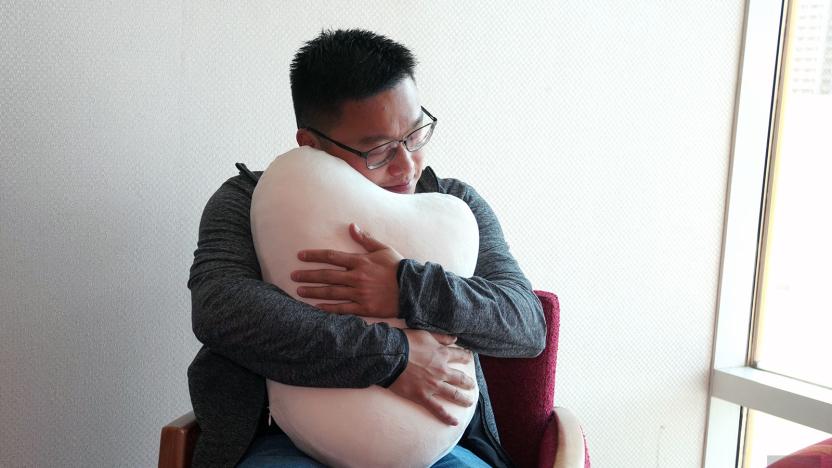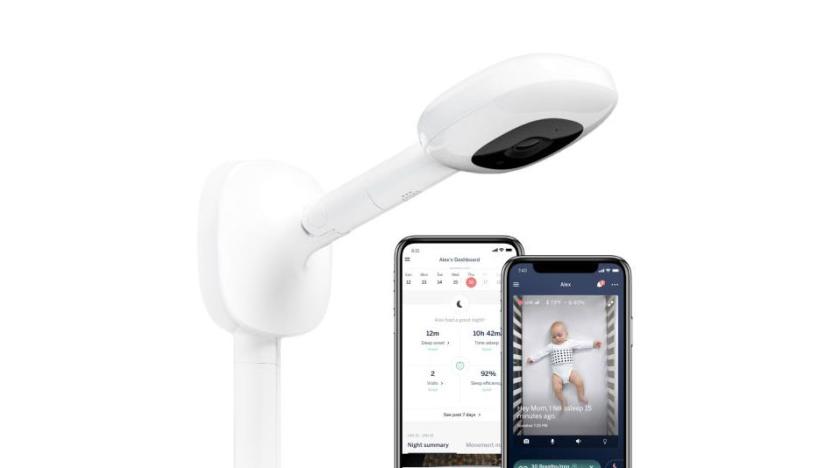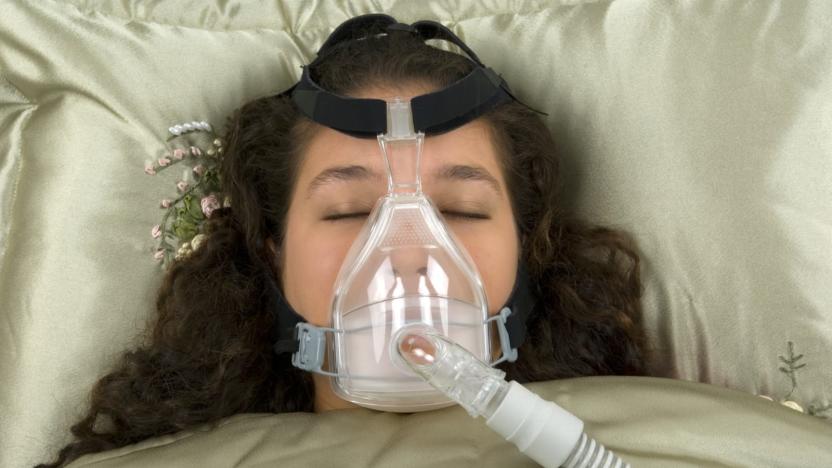breathing
Latest

Hugging this pulsating cushion apparently suppresses your anxiety
Fufuly is yet another anxiety-reducing cushion from Yukai Engineering, featuring a gentle rhythmical pulsation as the main therapeutic tool.

Nanit launches a Pro version of its smart baby monitor
It has a slimmer design, and a 1080p camera.

Muse's new meditation headband is designed to help you sleep
Muse first launched its brain-sensing headband back in 2013. Designed to take the guesswork out of meditation by providing real-time feedback on your brain and body's activity, the device has seen a couple of iterations over the years, and now its back with a completely new form factor. Gone are the rubbery cushions and external metal components -- the whole thing is now covered in a plush, breathable fabric and has been designed to fit better and more comfortably on a wider variety of head sizes.

Withings adds sleep apnea detection to its tracking mat
There are countless products available that help you track your sleep, giving you insights into your sleep patterns and quality. But there's been nothing to help snoozers identify sleep apnea, a potentially-serious condition that could traditionally only be diagnosed by a sleep clinic. Now, health device maker Withings has released a new update to its sleep tracking mat that could help users recognize the symptoms of this disorder.

Mightier is helping calm kids down through mobile games
Learning how to regulate your emotions is a fundamental skill, but it can be tough for kids, especially those with challenging behaviors, oppositional disorder, ADHD and autism. Mightier, by Neuromotion Labs, is a gaming platform that teaches kids a valuable set of emotion management skills using just a phone, an app and a heart rate monitor.

WiFi mesh networks can detect your breathing
In the world of indoor security systems, motion detection usually relies on cameras or at least dedicated sensors. Both types of solution add to hardware plus installation costs, not to mention that not everyone is comfortable with having cameras pointing at them all the time. Origin Wireless, on the other hand, found a way to make use of WiFi signals bouncing around a room to detect even the slightest movement -- down to something as subtle as a person's breathing rate. What's more, this "Time Reversal Machine" technology is essentially just some clever algorithmic work with little burden on the processor, so it can potentially be added to any existing WiFi mesh routers via a firmware update. In other words, security system vendors should take note.

FDA clears implant that treats severe sleep apnea
Sleep apnea (where your brain doesn't properly send breathing signals while resting) is horrible enough by itself, but the solutions to it can be scary: you may have to take medication, rely on ungainly breathing machines or opt for invasive surgery. You might have a gentler treatment going forward, though. The US Food and Drug Administration has approved an implantable device, Respicardia's Remede System, that fights more serious cases of sleep apnea.

Philips camera monitors baby vitals from afar
Sure, junior looks fine sleeping on the baby-cam, but do you know her or his oxygen level, heartbeat and breathing rate, you monster? Of course not (don't worry, you're a good parent), because there's no way of monitoring such things short of hooking the poor tyke up to a pulse oxymeter. At least, until now. Philips has revealed a camera that can detect all those things from afar, without touching the patient. The fruit of the companies contactless monitoring project, it can get a pulse rate, breathing rate and blood oxygen level by detecting changes in skin color that are invisible to the naked eye.

Google Glass can tell if you're stressed
It's not always easy to tell when your stress levels are through the roof, and you may not always want to break out a heart rate sensor just to find out when it's time to relax. You might not have to, if researchers at Georgia Tech and MIT have their way; they've developed BioGlass, an Android app that uses Google Glass to determine how frazzled you are. The software measures your heart and breathing rates by checking for tiny movements picked up by Glass' accelerometer, gyroscope and front-facing camera. In theory, you'd only have to wear the smart eyepiece to know when it's time to calm down.

Spire breathing monitor can tell if you're stressed, relaxed or focused
Samsung's Galaxy S5 is supposed to be able to measure stress, but there's something about its "heart-rate variability" test that just isn't very convincing. (Namely, if you enjoy a brisk walk and raise your heart-rate slightly, the phone will sometimes report an increase in "stress.") By contrast, a new hip-worn sensor called "Spire" ignores your pulse in favor of monitoring breathing patterns instead. Its creators claim that these patterns can reveal periods of "tension, relaxation and focus," as well as allowing standard fitness tracking.

WiFi tech lets scientists monitor your vital signs through walls
MIT's CSAIL lab has just taken its very cool but kinda creepy WiFi motion tracking to a new level: monitoring your vital signs from another room. Last we saw, the same researchers bounced low-powered WiFi signals (100x less than a home router) off of individuals to finely track their position behind a wall. The resulting 10cm (four inch) precision was nothing compared to what they can now do, however. Fancier algorithms enabled the system to approximate subjects' volumes within millimeters, and then calculate their breathing level by amplifying and observing the subtle changes over time. From breathing levels, the researchers could extrapolate heart rate with 99 percent accuracy -- something foreshadowed uncannily by earlier research. The tech may lead to non-invasive vital sign monitoring, more advanced baby monitors and other, more sinister, applications.

NCKU's i-Transport robot wheelchair helps riders reach full height
Those who have to use a wheelchair are often bound to the elevation of the seat if they want to reach something, which isn't fair when some parts of our world are still built for standing height. Taiwan's National Cheng Kung University is redressing that imbalance with the i-Transport. Its robotic vehicle can raise the driver to an upright level and shift them into a better position to grab objects that wouldn't otherwise be at arm's length. The added independence doesn't stop with the assistance, either, as the i-Transport carries its own blood pressure and breathing monitors to keep checkups to a minimum. NCKU hasn't said how likely it is that we'll see the robot enter mass production, but we hope it forges ahead -- the potential freedom would be worth the effort.

Samsung files patents for robot that mimics human walking and breathing, ratchets up the creepy factor
As much as Samsung is big on robots, it hasn't gone all-out on the idea until a just-published quartet of patent applications. The filings have a robot more directly mimicking a human walk and adjusting the scale to get the appropriate speed without the unnatural, perpetually bent gait of certain peers. To safely get from point A to point B, any path is chopped up into a series of walking motions, and the robot constantly checks against its center of gravity to stay upright as it walks uphill or down. All very clever, but we'd say Samsung is almost too fond of the uncanny valley: one patent has rotating joints coordinate to simulate the chest heaves of human breathing. We don't know if the company will ever put the patents to use; these could be just feverish dreams of one-upping Honda's ASIMO at its own game. But if it does, we could be looking at Samsung-made androids designed like humans rather than for them.

Piezoelectric system turns your balmy breath into pungent power
Researchers at the University of Wisconsin-Madison have come up with a way to produce electricity from just about the most renewable source known to man -- his own breath. It's all thanks to a plastic microbelt developed by engineers Xudong Wang, Chengliang Sun and Jian Shi. Made of a material known as polyvinylidene fluoride (PVDF), this belt produces an electric charge whenever low-speed airflow passes over it and causes it to vibrate -- a result of that vaunted piezoelectric effect. Eventually, Wang and his team were able to tinker with their system to the point where it could produce enough current to charge small electronic devices. "The airflow of normal human respiration is typically below about two meters per second," Wang explained. "We calculated that if we could make this material thin enough, small vibrations could produce a microwatt of electrical energy that could be useful for sensors or other devices implanted in the face." The researchers say their technology could be used to power smaller biomedical devices like blood monitors and pacemaker batteries, which typically don't demand vast amounts of energy. No word yet on when this system could make its way to the mainstream, but we'll be waiting with bated breath.

Researchers use wireless network to monitor breathing, could save lives
When Neal Patwari and his team of researchers developed a wireless network capable of seeing through walls, we assumed they were simply looking to cultivate their Alastor Moody-like superpowers. Turns out, they had far more important things on their minds. Patwari and his colleagues at the University of Utah have now penned a new study in which they demonstrate how their motion detecting technology could be used to monitor breathing patterns, as well, potentially enabling doctors to keep closer track of patients with sleep apnea or babies susceptible to sudden infant death syndrome (SIDS). To do this, Patwari reclined on a hospital bed and surrounded himself with 20 wireless transceivers operating at a frequency of 2.4GHz, as pictured above. He then timed his breathing at about 15 breaths per minute (the average rate for a resting adult), which he measured with his array of nodes and a carbon dioxide monitor. The engineer ultimately found that his system's algorithm could accurately measure respiration within 0.4 to 0.2 breaths per minute -- a relatively low error rate, since most monitors round off to the nearest full breath. Patwari says this development could offer a non-invasive and low-cost alternative to the devices used in most hospitals, and hopes to implement his technology into at-home baby monitors, as well. He acknowledges, however, that it will likely take at least five years before any of that happens -- so don't hold your breath. Full PR after the break.

Somnus Sleep Shirt watches while you sleep, won't be creepy about it (video)
Monitoring sleep patterns usually involves a hydra of sensors that keep track of brain activity, muscle movements and heart rates, but a startup called Nyx Devices has developed a new night shirt that can evaluate the quality of a user's slumber by analyzing only breathing patterns. The form-fitting Somnus Sleep Shirt is embedded with two sensors that keep track of a person's overnight breathing and transmit this information to a small data recorder, which slides into the lower corner of the nightie. When a user wakes up, he or she can upload their stats to Nyx's website, where they can generate more detailed analytics and log their caffeine and alcohol intake to find out how all those martini lunches affect their snoozing. Co-inventor Matt Bianchi, a sleep neurologist at Massachusetts General Hospital, thinks the Somnus could help patients suffering from insomnia, who often have difficulty determining how much shuteye they actually get. It's worth noting, though, that this exclusively respiratory approach is still considered experimental and Nyx still has to conduct a few at-home tests before bringing the shirt to market next year, hopefully for less than $100. Until then, we'll just keep tossing and turning in our Spider Man jammies. Stroll past the break for an appropriately soporific video.

Researchers create functioning human lung on a microchip
Researchers at Harvard University have successfully created a functioning, respirating human 'lung' on a chip in a lab. Made using human and blood vessel cells and a microchip, the translucent lung is far simpler in terms of observation than traditional, actual human lungs (for obvious reasons), in a small convenient package about the size of a pencil eraser. The researchers have demonstrated its effectiveness and are now moving toward showing its ability to replicate gas exchange between lung cells and the bloodstream. Down the road a bit more, the team hopes to produce other organs on chips, and hook them all up to the already operational heart on a chip. And somewhere in the world, Margaret Atwood and her pigoons are rejoicing, right? Here's to the future. Video description of the device is below.

Zyxio's 'sensawaft' tech lets you control a cursor with your breath, you lazy jerk
We never knew just how much work it was moving our mouse around our desktop until we blew ourself silly on Zyxio's breath-enabled sensawaft tech. The sensor detects the directionality of breathing, which sounds really easy in theory but took a bit of learning in practice. After a couple minutes of trying, however, we were "blowing with our mind" as the promotional materials suggest, and while we wouldn't call ourselves halfway accurate, we could see ourselves suggesting a mild amount of cursor direction with very little effort after a day or so of use. There's an obvious application for the disabled, but Zyxio also thinks it can talk gamers into using it as a "third hand," and envisions other applications such as controlling a mobile phone or zooming in and out of a GPS view in a car. We can't see it taking the industry by storm, but sensawaft is certainly an impressive and entertaining technology, and with devices in the projected $70 range in Q2 or Q3 of this year, it might not be too expensive for a novelty buy. Check out a video of it in action after the break.

Snoozy the Sloth is a breathing, napping toy after our own hearts
You know what would have been awesome to have as a toy when we were growing up? Not a baby to swaddle and feed, or a Barbie doll to dress up and imagine careers for, or a fake pet to worry about neglecting. No, we'd have preferred Snoozy the Sloth, who merely breathes and take naps with you when you cuddle him. The sloth's epic simplicity -- a plush toy with Arduino guts and a 2 DC motor diaphragm to pump the air in his "lungs" -- makes him a perfect companion for our downtime. Created by Justin Blinder for a toy-making class at Parsons The New School for Design, Snoozy is merely a prototype, but we really hope the toy industry is watching: they could learn a lot, in our sleepy, sleepy opinion. There's a video of him napping after the break (and hit the read link for a shorter one of his innards). Yawn.[Via Gizmodo, thanks, Jesse]

Arduino-based 'sigh collector' is clever, pointless
Of all the things we are inclined to take for granted, the weary exhalation of air that is commonly referred to as a "sigh" easily tops our list (other things that we take for granted: our mother's love and Laser Pink Floyd at the planetarium on Saturday nights). But not Instructables member mkontop, however: this guy is clearly fascinated by the theory, practice, and ramifications of sighing, even going so far as to build a device that not only monitors his breathing and measures his sighing, but then goes on to store the corresponding amount of exhaled air in a box nearby. To what end, you ask? Perhaps you can ask Marcel Duchamp next time he's in town. Hit that read link to build one for yourself, but not before peeping that video after the break.








